Financial Management: Financial Statements, Ratios, and Performance
VerifiedAdded on 2023/06/14
|15
|2848
|491
Report
AI Summary
This report provides an overview of financial management, emphasizing its importance in organizational operations. It defines financial management, highlighting its role in effective planning, resource allocation, and control. The report discusses key financial statements, including income statements, balance sheets, and cash flow statements, and explains how ratios are used to assess a company's profitability, liquidity, and efficiency. It includes a practical component with an income statement and balance sheet prepared using Excel for a sample organization. Furthermore, the report uses a case study to illustrate how businesses can improve their financial performance by analyzing financial ratios and implementing strategies to enhance profitability and manage cash flow effectively. Concluding with the importance of financial management for informed decision-making and sustainable business growth.

Importance of
Financial management
Financial management
Paraphrase This Document
Need a fresh take? Get an instant paraphrase of this document with our AI Paraphraser
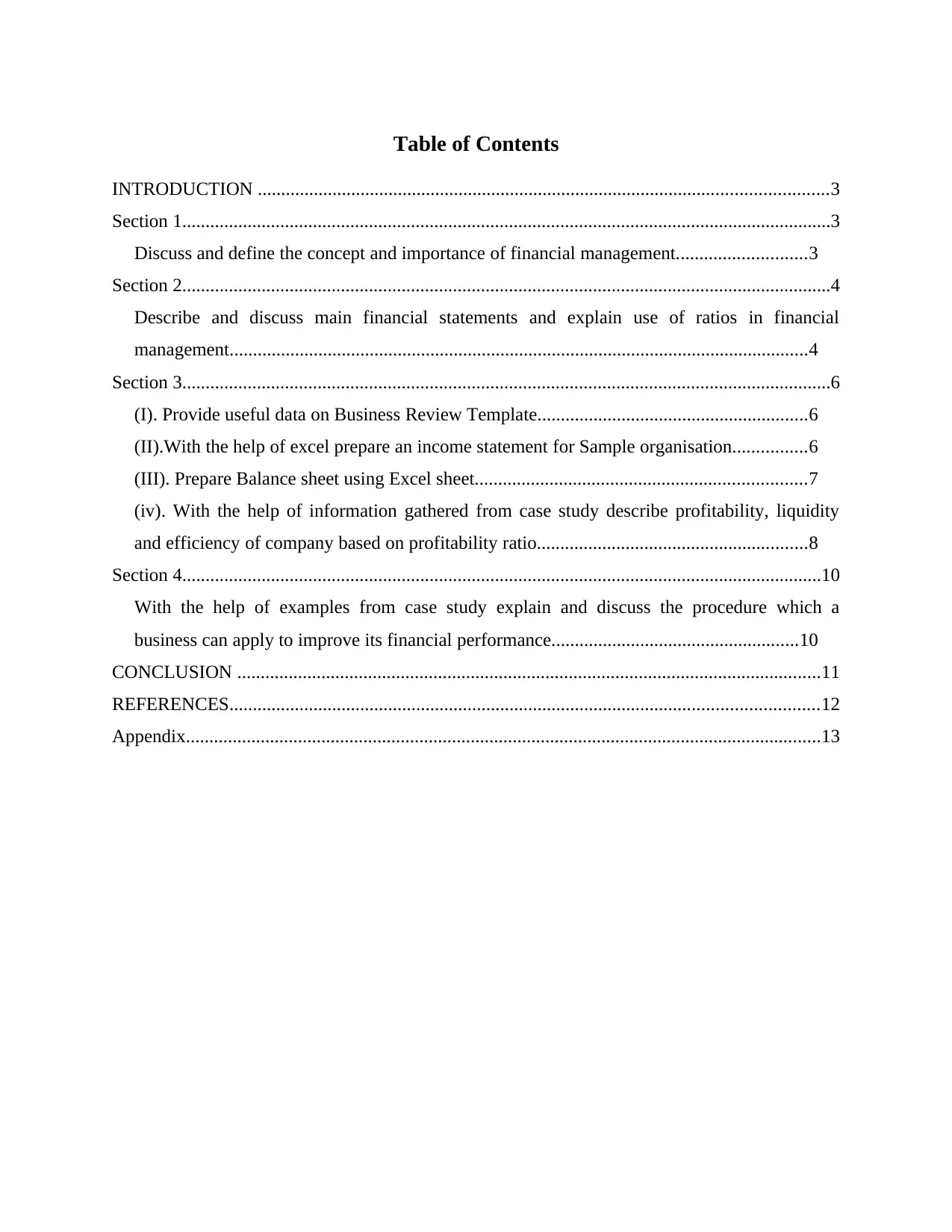
Table of Contents
INTRODUCTION ..........................................................................................................................3
Section 1...........................................................................................................................................3
Discuss and define the concept and importance of financial management............................3
Section 2...........................................................................................................................................4
Describe and discuss main financial statements and explain use of ratios in financial
management............................................................................................................................4
Section 3...........................................................................................................................................6
(I). Provide useful data on Business Review Template..........................................................6
(II).With the help of excel prepare an income statement for Sample organisation................6
(III). Prepare Balance sheet using Excel sheet.......................................................................7
(iv). With the help of information gathered from case study describe profitability, liquidity
and efficiency of company based on profitability ratio..........................................................8
Section 4.........................................................................................................................................10
With the help of examples from case study explain and discuss the procedure which a
business can apply to improve its financial performance.....................................................10
CONCLUSION .............................................................................................................................11
REFERENCES..............................................................................................................................12
Appendix........................................................................................................................................13
INTRODUCTION ..........................................................................................................................3
Section 1...........................................................................................................................................3
Discuss and define the concept and importance of financial management............................3
Section 2...........................................................................................................................................4
Describe and discuss main financial statements and explain use of ratios in financial
management............................................................................................................................4
Section 3...........................................................................................................................................6
(I). Provide useful data on Business Review Template..........................................................6
(II).With the help of excel prepare an income statement for Sample organisation................6
(III). Prepare Balance sheet using Excel sheet.......................................................................7
(iv). With the help of information gathered from case study describe profitability, liquidity
and efficiency of company based on profitability ratio..........................................................8
Section 4.........................................................................................................................................10
With the help of examples from case study explain and discuss the procedure which a
business can apply to improve its financial performance.....................................................10
CONCLUSION .............................................................................................................................11
REFERENCES..............................................................................................................................12
Appendix........................................................................................................................................13
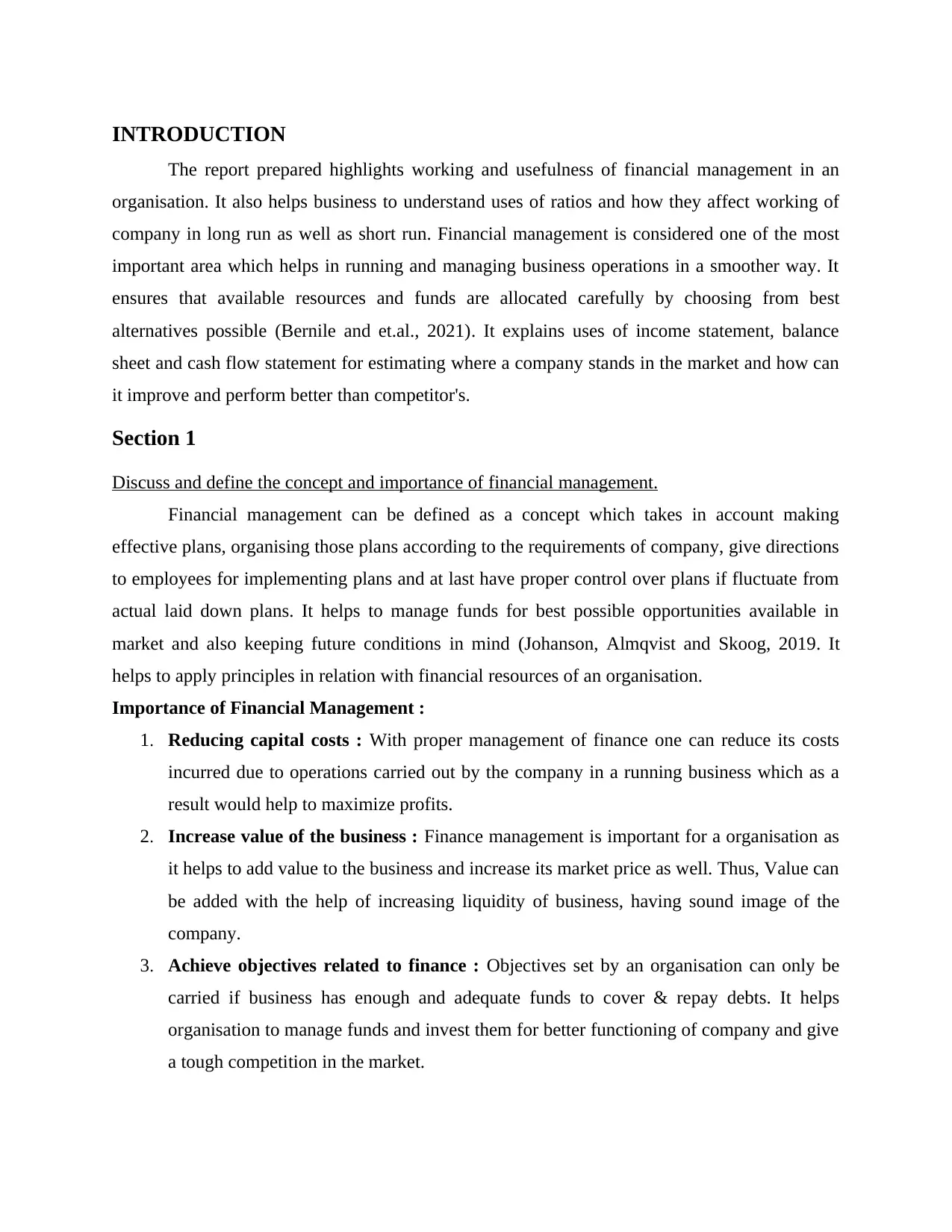
INTRODUCTION
The report prepared highlights working and usefulness of financial management in an
organisation. It also helps business to understand uses of ratios and how they affect working of
company in long run as well as short run. Financial management is considered one of the most
important area which helps in running and managing business operations in a smoother way. It
ensures that available resources and funds are allocated carefully by choosing from best
alternatives possible (Bernile and et.al., 2021). It explains uses of income statement, balance
sheet and cash flow statement for estimating where a company stands in the market and how can
it improve and perform better than competitor's.
Section 1
Discuss and define the concept and importance of financial management.
Financial management can be defined as a concept which takes in account making
effective plans, organising those plans according to the requirements of company, give directions
to employees for implementing plans and at last have proper control over plans if fluctuate from
actual laid down plans. It helps to manage funds for best possible opportunities available in
market and also keeping future conditions in mind (Johanson, Almqvist and Skoog, 2019. It
helps to apply principles in relation with financial resources of an organisation.
Importance of Financial Management :
1. Reducing capital costs : With proper management of finance one can reduce its costs
incurred due to operations carried out by the company in a running business which as a
result would help to maximize profits.
2. Increase value of the business : Finance management is important for a organisation as
it helps to add value to the business and increase its market price as well. Thus, Value can
be added with the help of increasing liquidity of business, having sound image of the
company.
3. Achieve objectives related to finance : Objectives set by an organisation can only be
carried if business has enough and adequate funds to cover & repay debts. It helps
organisation to manage funds and invest them for better functioning of company and give
a tough competition in the market.
The report prepared highlights working and usefulness of financial management in an
organisation. It also helps business to understand uses of ratios and how they affect working of
company in long run as well as short run. Financial management is considered one of the most
important area which helps in running and managing business operations in a smoother way. It
ensures that available resources and funds are allocated carefully by choosing from best
alternatives possible (Bernile and et.al., 2021). It explains uses of income statement, balance
sheet and cash flow statement for estimating where a company stands in the market and how can
it improve and perform better than competitor's.
Section 1
Discuss and define the concept and importance of financial management.
Financial management can be defined as a concept which takes in account making
effective plans, organising those plans according to the requirements of company, give directions
to employees for implementing plans and at last have proper control over plans if fluctuate from
actual laid down plans. It helps to manage funds for best possible opportunities available in
market and also keeping future conditions in mind (Johanson, Almqvist and Skoog, 2019. It
helps to apply principles in relation with financial resources of an organisation.
Importance of Financial Management :
1. Reducing capital costs : With proper management of finance one can reduce its costs
incurred due to operations carried out by the company in a running business which as a
result would help to maximize profits.
2. Increase value of the business : Finance management is important for a organisation as
it helps to add value to the business and increase its market price as well. Thus, Value can
be added with the help of increasing liquidity of business, having sound image of the
company.
3. Achieve objectives related to finance : Objectives set by an organisation can only be
carried if business has enough and adequate funds to cover & repay debts. It helps
organisation to manage funds and invest them for better functioning of company and give
a tough competition in the market.
⊘ This is a preview!⊘
Do you want full access?
Subscribe today to unlock all pages.

Trusted by 1+ million students worldwide
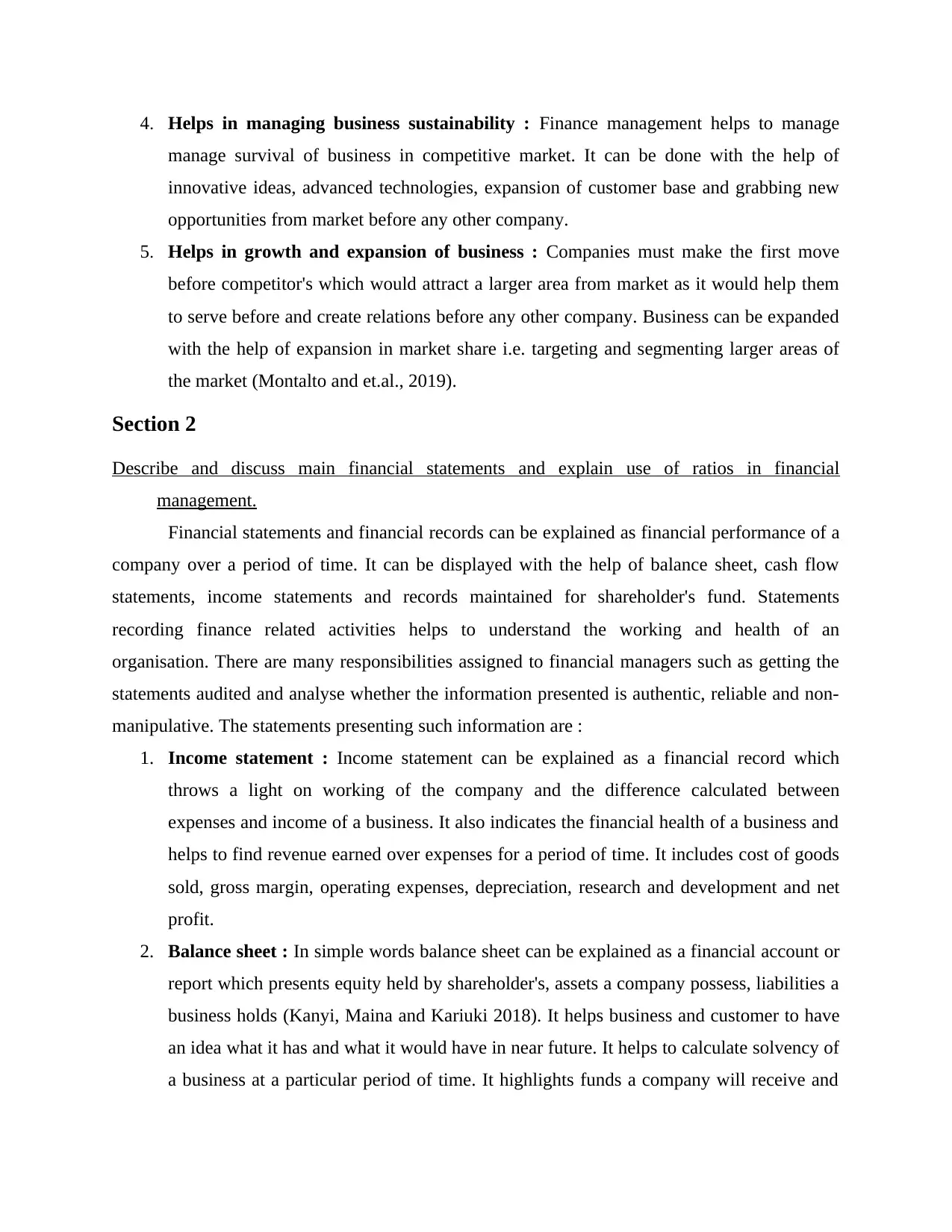
4. Helps in managing business sustainability : Finance management helps to manage
manage survival of business in competitive market. It can be done with the help of
innovative ideas, advanced technologies, expansion of customer base and grabbing new
opportunities from market before any other company.
5. Helps in growth and expansion of business : Companies must make the first move
before competitor's which would attract a larger area from market as it would help them
to serve before and create relations before any other company. Business can be expanded
with the help of expansion in market share i.e. targeting and segmenting larger areas of
the market (Montalto and et.al., 2019).
Section 2
Describe and discuss main financial statements and explain use of ratios in financial
management.
Financial statements and financial records can be explained as financial performance of a
company over a period of time. It can be displayed with the help of balance sheet, cash flow
statements, income statements and records maintained for shareholder's fund. Statements
recording finance related activities helps to understand the working and health of an
organisation. There are many responsibilities assigned to financial managers such as getting the
statements audited and analyse whether the information presented is authentic, reliable and non-
manipulative. The statements presenting such information are :
1. Income statement : Income statement can be explained as a financial record which
throws a light on working of the company and the difference calculated between
expenses and income of a business. It also indicates the financial health of a business and
helps to find revenue earned over expenses for a period of time. It includes cost of goods
sold, gross margin, operating expenses, depreciation, research and development and net
profit.
2. Balance sheet : In simple words balance sheet can be explained as a financial account or
report which presents equity held by shareholder's, assets a company possess, liabilities a
business holds (Kanyi, Maina and Kariuki 2018). It helps business and customer to have
an idea what it has and what it would have in near future. It helps to calculate solvency of
a business at a particular period of time. It highlights funds a company will receive and
manage survival of business in competitive market. It can be done with the help of
innovative ideas, advanced technologies, expansion of customer base and grabbing new
opportunities from market before any other company.
5. Helps in growth and expansion of business : Companies must make the first move
before competitor's which would attract a larger area from market as it would help them
to serve before and create relations before any other company. Business can be expanded
with the help of expansion in market share i.e. targeting and segmenting larger areas of
the market (Montalto and et.al., 2019).
Section 2
Describe and discuss main financial statements and explain use of ratios in financial
management.
Financial statements and financial records can be explained as financial performance of a
company over a period of time. It can be displayed with the help of balance sheet, cash flow
statements, income statements and records maintained for shareholder's fund. Statements
recording finance related activities helps to understand the working and health of an
organisation. There are many responsibilities assigned to financial managers such as getting the
statements audited and analyse whether the information presented is authentic, reliable and non-
manipulative. The statements presenting such information are :
1. Income statement : Income statement can be explained as a financial record which
throws a light on working of the company and the difference calculated between
expenses and income of a business. It also indicates the financial health of a business and
helps to find revenue earned over expenses for a period of time. It includes cost of goods
sold, gross margin, operating expenses, depreciation, research and development and net
profit.
2. Balance sheet : In simple words balance sheet can be explained as a financial account or
report which presents equity held by shareholder's, assets a company possess, liabilities a
business holds (Kanyi, Maina and Kariuki 2018). It helps business and customer to have
an idea what it has and what it would have in near future. It helps to calculate solvency of
a business at a particular period of time. It highlights funds a company will receive and
Paraphrase This Document
Need a fresh take? Get an instant paraphrase of this document with our AI Paraphraser
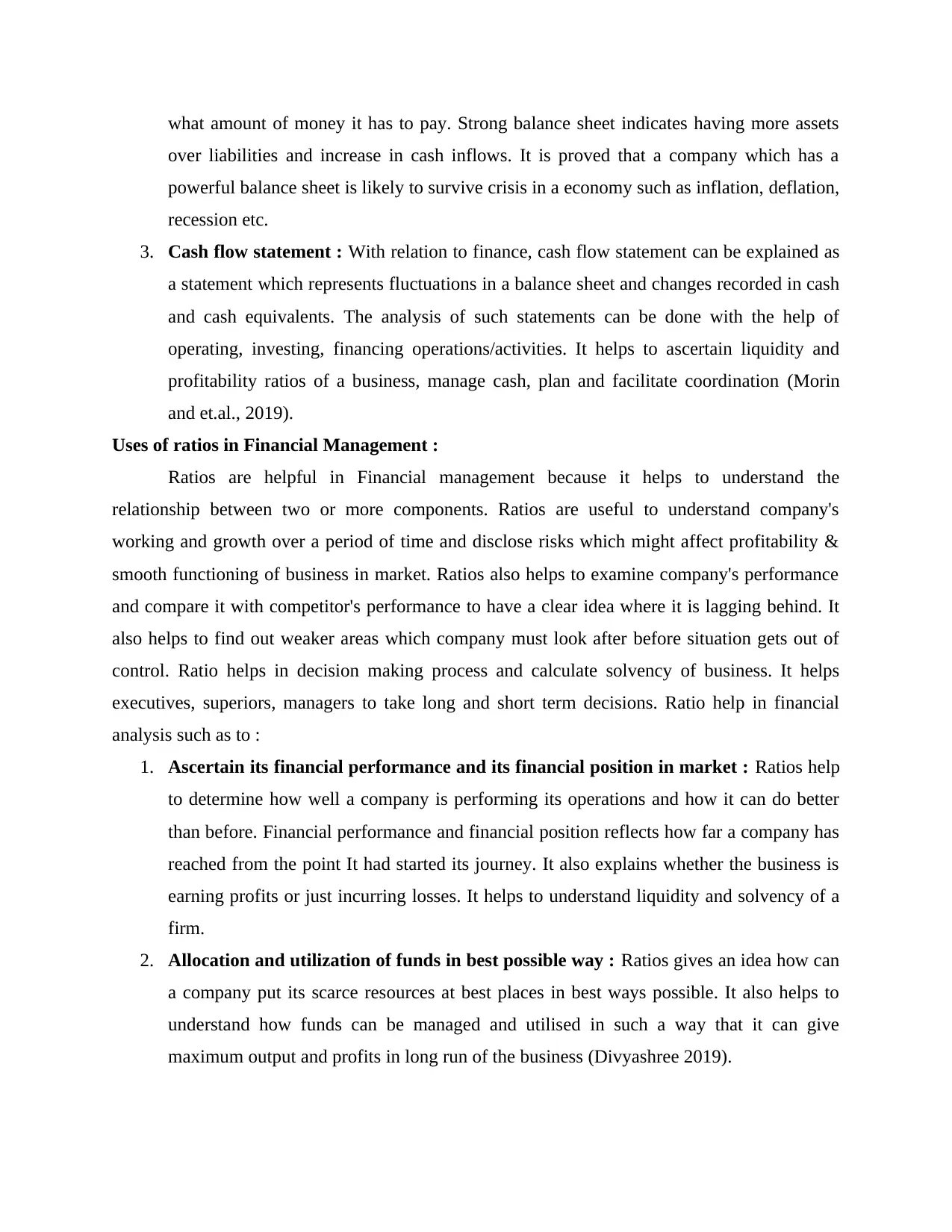
what amount of money it has to pay. Strong balance sheet indicates having more assets
over liabilities and increase in cash inflows. It is proved that a company which has a
powerful balance sheet is likely to survive crisis in a economy such as inflation, deflation,
recession etc.
3. Cash flow statement : With relation to finance, cash flow statement can be explained as
a statement which represents fluctuations in a balance sheet and changes recorded in cash
and cash equivalents. The analysis of such statements can be done with the help of
operating, investing, financing operations/activities. It helps to ascertain liquidity and
profitability ratios of a business, manage cash, plan and facilitate coordination (Morin
and et.al., 2019).
Uses of ratios in Financial Management :
Ratios are helpful in Financial management because it helps to understand the
relationship between two or more components. Ratios are useful to understand company's
working and growth over a period of time and disclose risks which might affect profitability &
smooth functioning of business in market. Ratios also helps to examine company's performance
and compare it with competitor's performance to have a clear idea where it is lagging behind. It
also helps to find out weaker areas which company must look after before situation gets out of
control. Ratio helps in decision making process and calculate solvency of business. It helps
executives, superiors, managers to take long and short term decisions. Ratio help in financial
analysis such as to :
1. Ascertain its financial performance and its financial position in market : Ratios help
to determine how well a company is performing its operations and how it can do better
than before. Financial performance and financial position reflects how far a company has
reached from the point It had started its journey. It also explains whether the business is
earning profits or just incurring losses. It helps to understand liquidity and solvency of a
firm.
2. Allocation and utilization of funds in best possible way : Ratios gives an idea how can
a company put its scarce resources at best places in best ways possible. It also helps to
understand how funds can be managed and utilised in such a way that it can give
maximum output and profits in long run of the business (Divyashree 2019).
over liabilities and increase in cash inflows. It is proved that a company which has a
powerful balance sheet is likely to survive crisis in a economy such as inflation, deflation,
recession etc.
3. Cash flow statement : With relation to finance, cash flow statement can be explained as
a statement which represents fluctuations in a balance sheet and changes recorded in cash
and cash equivalents. The analysis of such statements can be done with the help of
operating, investing, financing operations/activities. It helps to ascertain liquidity and
profitability ratios of a business, manage cash, plan and facilitate coordination (Morin
and et.al., 2019).
Uses of ratios in Financial Management :
Ratios are helpful in Financial management because it helps to understand the
relationship between two or more components. Ratios are useful to understand company's
working and growth over a period of time and disclose risks which might affect profitability &
smooth functioning of business in market. Ratios also helps to examine company's performance
and compare it with competitor's performance to have a clear idea where it is lagging behind. It
also helps to find out weaker areas which company must look after before situation gets out of
control. Ratio helps in decision making process and calculate solvency of business. It helps
executives, superiors, managers to take long and short term decisions. Ratio help in financial
analysis such as to :
1. Ascertain its financial performance and its financial position in market : Ratios help
to determine how well a company is performing its operations and how it can do better
than before. Financial performance and financial position reflects how far a company has
reached from the point It had started its journey. It also explains whether the business is
earning profits or just incurring losses. It helps to understand liquidity and solvency of a
firm.
2. Allocation and utilization of funds in best possible way : Ratios gives an idea how can
a company put its scarce resources at best places in best ways possible. It also helps to
understand how funds can be managed and utilised in such a way that it can give
maximum output and profits in long run of the business (Divyashree 2019).
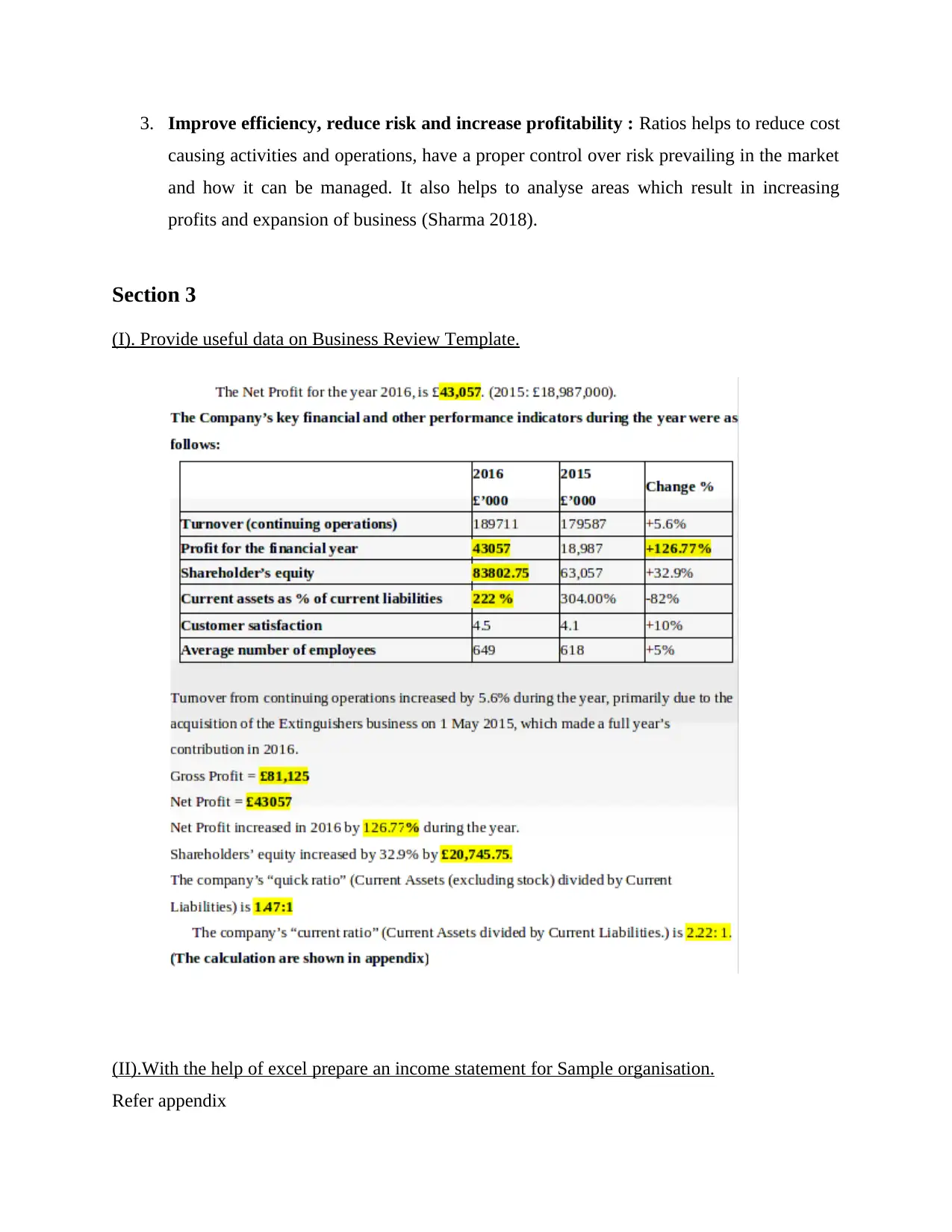
3. Improve efficiency, reduce risk and increase profitability : Ratios helps to reduce cost
causing activities and operations, have a proper control over risk prevailing in the market
and how it can be managed. It also helps to analyse areas which result in increasing
profits and expansion of business (Sharma 2018).
Section 3
(I). Provide useful data on Business Review Template.
(II).With the help of excel prepare an income statement for Sample organisation.
Refer appendix
causing activities and operations, have a proper control over risk prevailing in the market
and how it can be managed. It also helps to analyse areas which result in increasing
profits and expansion of business (Sharma 2018).
Section 3
(I). Provide useful data on Business Review Template.
(II).With the help of excel prepare an income statement for Sample organisation.
Refer appendix
⊘ This is a preview!⊘
Do you want full access?
Subscribe today to unlock all pages.

Trusted by 1+ million students worldwide
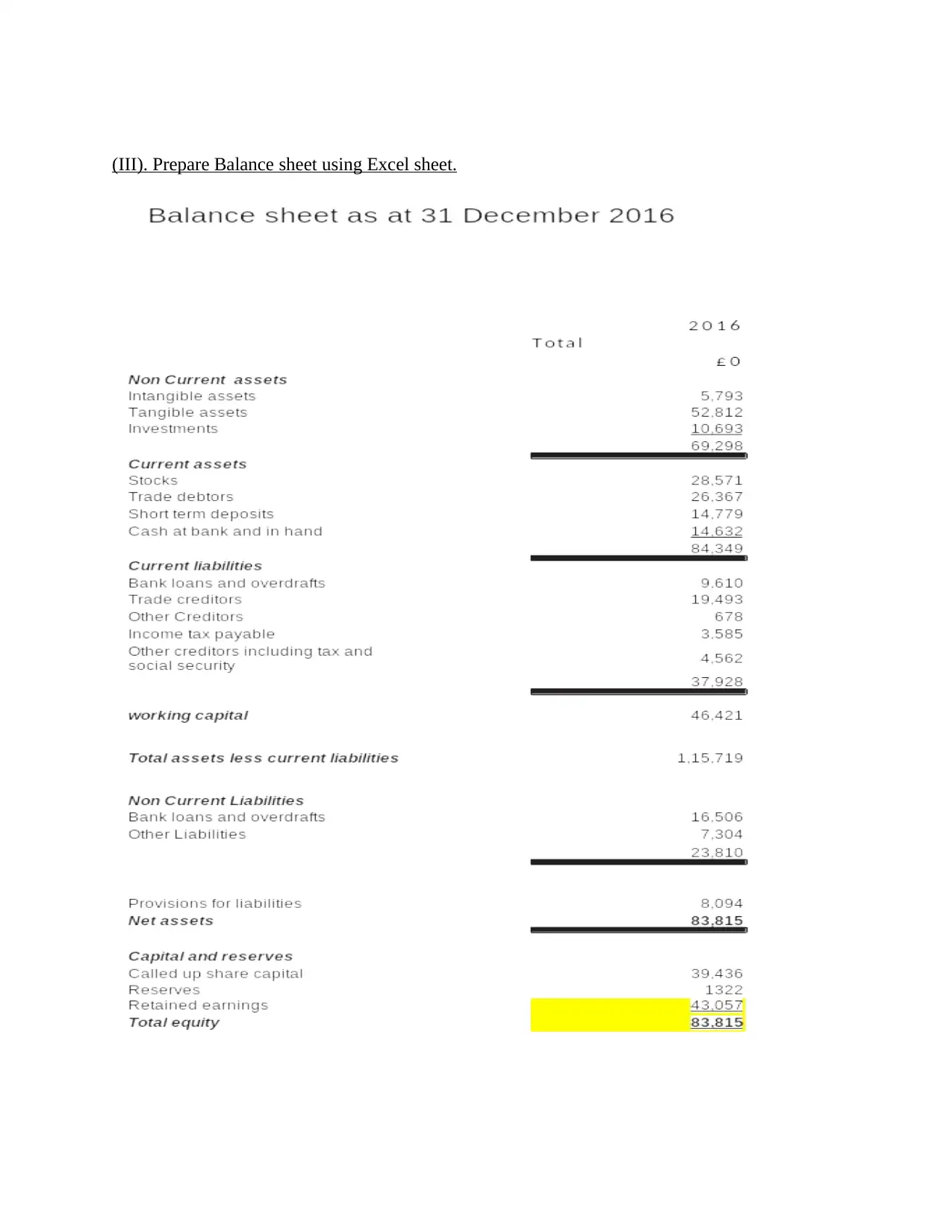
(III). Prepare Balance sheet using Excel sheet.
Paraphrase This Document
Need a fresh take? Get an instant paraphrase of this document with our AI Paraphraser
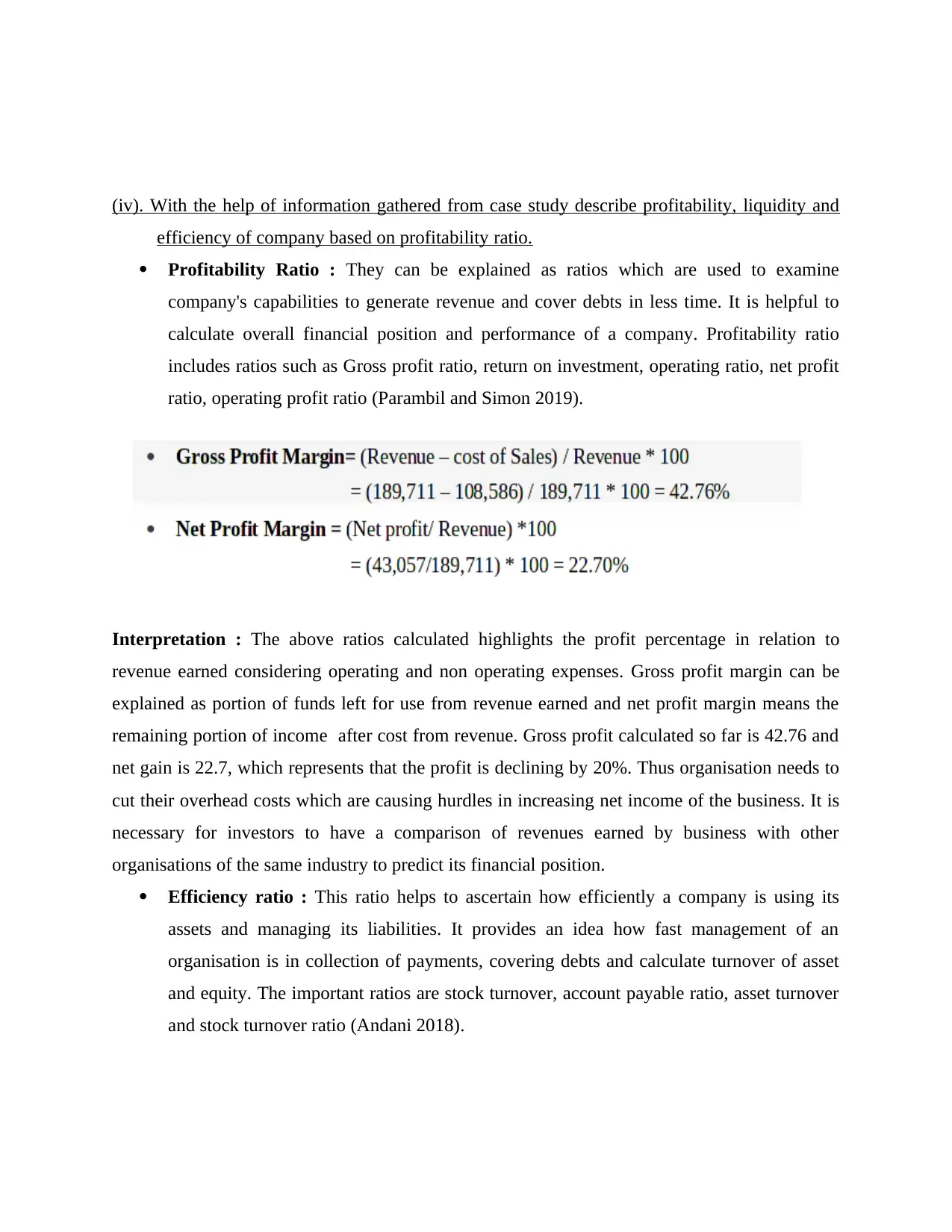
(iv). With the help of information gathered from case study describe profitability, liquidity and
efficiency of company based on profitability ratio.
Profitability Ratio : They can be explained as ratios which are used to examine
company's capabilities to generate revenue and cover debts in less time. It is helpful to
calculate overall financial position and performance of a company. Profitability ratio
includes ratios such as Gross profit ratio, return on investment, operating ratio, net profit
ratio, operating profit ratio (Parambil and Simon 2019).
Interpretation : The above ratios calculated highlights the profit percentage in relation to
revenue earned considering operating and non operating expenses. Gross profit margin can be
explained as portion of funds left for use from revenue earned and net profit margin means the
remaining portion of income after cost from revenue. Gross profit calculated so far is 42.76 and
net gain is 22.7, which represents that the profit is declining by 20%. Thus organisation needs to
cut their overhead costs which are causing hurdles in increasing net income of the business. It is
necessary for investors to have a comparison of revenues earned by business with other
organisations of the same industry to predict its financial position.
Efficiency ratio : This ratio helps to ascertain how efficiently a company is using its
assets and managing its liabilities. It provides an idea how fast management of an
organisation is in collection of payments, covering debts and calculate turnover of asset
and equity. The important ratios are stock turnover, account payable ratio, asset turnover
and stock turnover ratio (Andani 2018).
efficiency of company based on profitability ratio.
Profitability Ratio : They can be explained as ratios which are used to examine
company's capabilities to generate revenue and cover debts in less time. It is helpful to
calculate overall financial position and performance of a company. Profitability ratio
includes ratios such as Gross profit ratio, return on investment, operating ratio, net profit
ratio, operating profit ratio (Parambil and Simon 2019).
Interpretation : The above ratios calculated highlights the profit percentage in relation to
revenue earned considering operating and non operating expenses. Gross profit margin can be
explained as portion of funds left for use from revenue earned and net profit margin means the
remaining portion of income after cost from revenue. Gross profit calculated so far is 42.76 and
net gain is 22.7, which represents that the profit is declining by 20%. Thus organisation needs to
cut their overhead costs which are causing hurdles in increasing net income of the business. It is
necessary for investors to have a comparison of revenues earned by business with other
organisations of the same industry to predict its financial position.
Efficiency ratio : This ratio helps to ascertain how efficiently a company is using its
assets and managing its liabilities. It provides an idea how fast management of an
organisation is in collection of payments, covering debts and calculate turnover of asset
and equity. The important ratios are stock turnover, account payable ratio, asset turnover
and stock turnover ratio (Andani 2018).
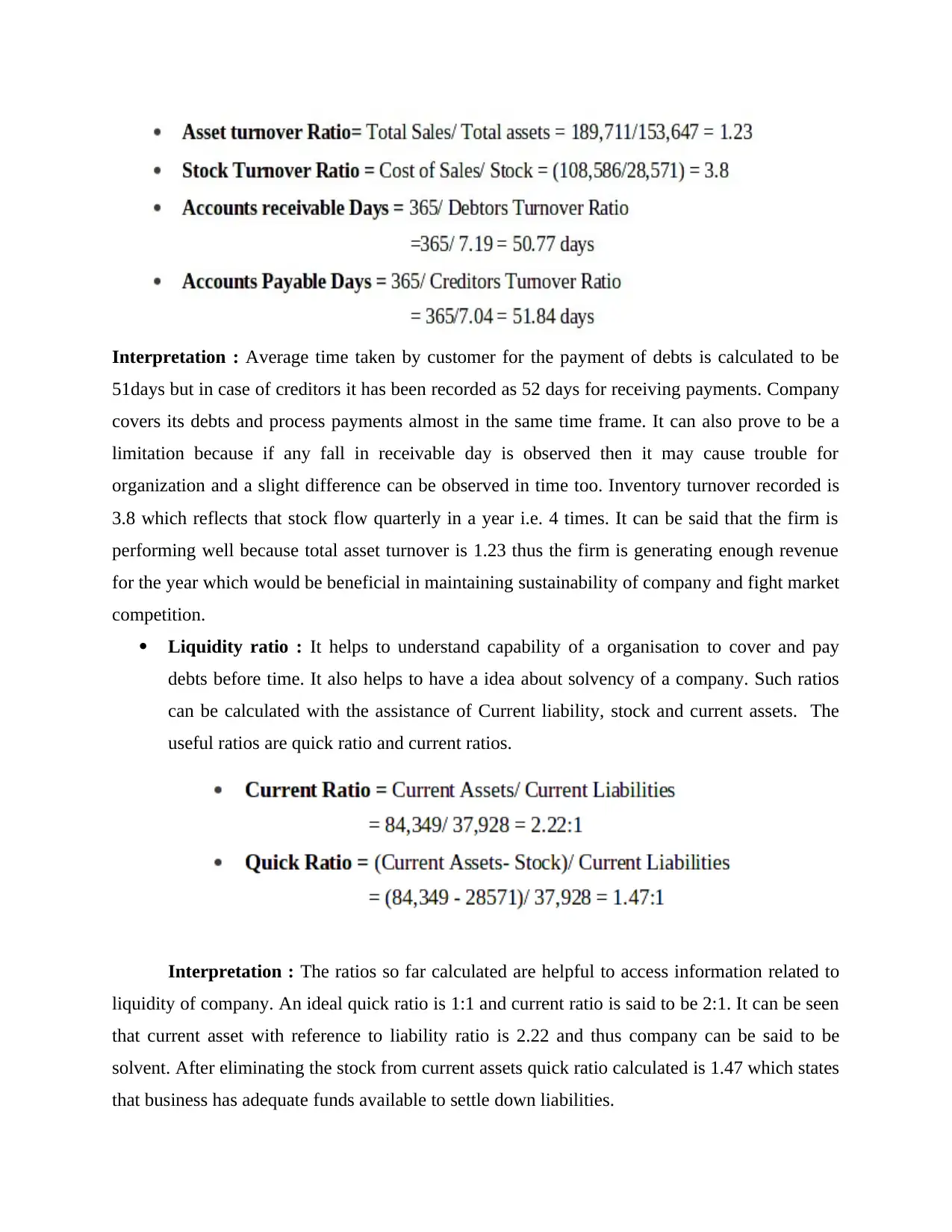
Interpretation : Average time taken by customer for the payment of debts is calculated to be
51days but in case of creditors it has been recorded as 52 days for receiving payments. Company
covers its debts and process payments almost in the same time frame. It can also prove to be a
limitation because if any fall in receivable day is observed then it may cause trouble for
organization and a slight difference can be observed in time too. Inventory turnover recorded is
3.8 which reflects that stock flow quarterly in a year i.e. 4 times. It can be said that the firm is
performing well because total asset turnover is 1.23 thus the firm is generating enough revenue
for the year which would be beneficial in maintaining sustainability of company and fight market
competition.
Liquidity ratio : It helps to understand capability of a organisation to cover and pay
debts before time. It also helps to have a idea about solvency of a company. Such ratios
can be calculated with the assistance of Current liability, stock and current assets. The
useful ratios are quick ratio and current ratios.
Interpretation : The ratios so far calculated are helpful to access information related to
liquidity of company. An ideal quick ratio is 1:1 and current ratio is said to be 2:1. It can be seen
that current asset with reference to liability ratio is 2.22 and thus company can be said to be
solvent. After eliminating the stock from current assets quick ratio calculated is 1.47 which states
that business has adequate funds available to settle down liabilities.
51days but in case of creditors it has been recorded as 52 days for receiving payments. Company
covers its debts and process payments almost in the same time frame. It can also prove to be a
limitation because if any fall in receivable day is observed then it may cause trouble for
organization and a slight difference can be observed in time too. Inventory turnover recorded is
3.8 which reflects that stock flow quarterly in a year i.e. 4 times. It can be said that the firm is
performing well because total asset turnover is 1.23 thus the firm is generating enough revenue
for the year which would be beneficial in maintaining sustainability of company and fight market
competition.
Liquidity ratio : It helps to understand capability of a organisation to cover and pay
debts before time. It also helps to have a idea about solvency of a company. Such ratios
can be calculated with the assistance of Current liability, stock and current assets. The
useful ratios are quick ratio and current ratios.
Interpretation : The ratios so far calculated are helpful to access information related to
liquidity of company. An ideal quick ratio is 1:1 and current ratio is said to be 2:1. It can be seen
that current asset with reference to liability ratio is 2.22 and thus company can be said to be
solvent. After eliminating the stock from current assets quick ratio calculated is 1.47 which states
that business has adequate funds available to settle down liabilities.
⊘ This is a preview!⊘
Do you want full access?
Subscribe today to unlock all pages.

Trusted by 1+ million students worldwide
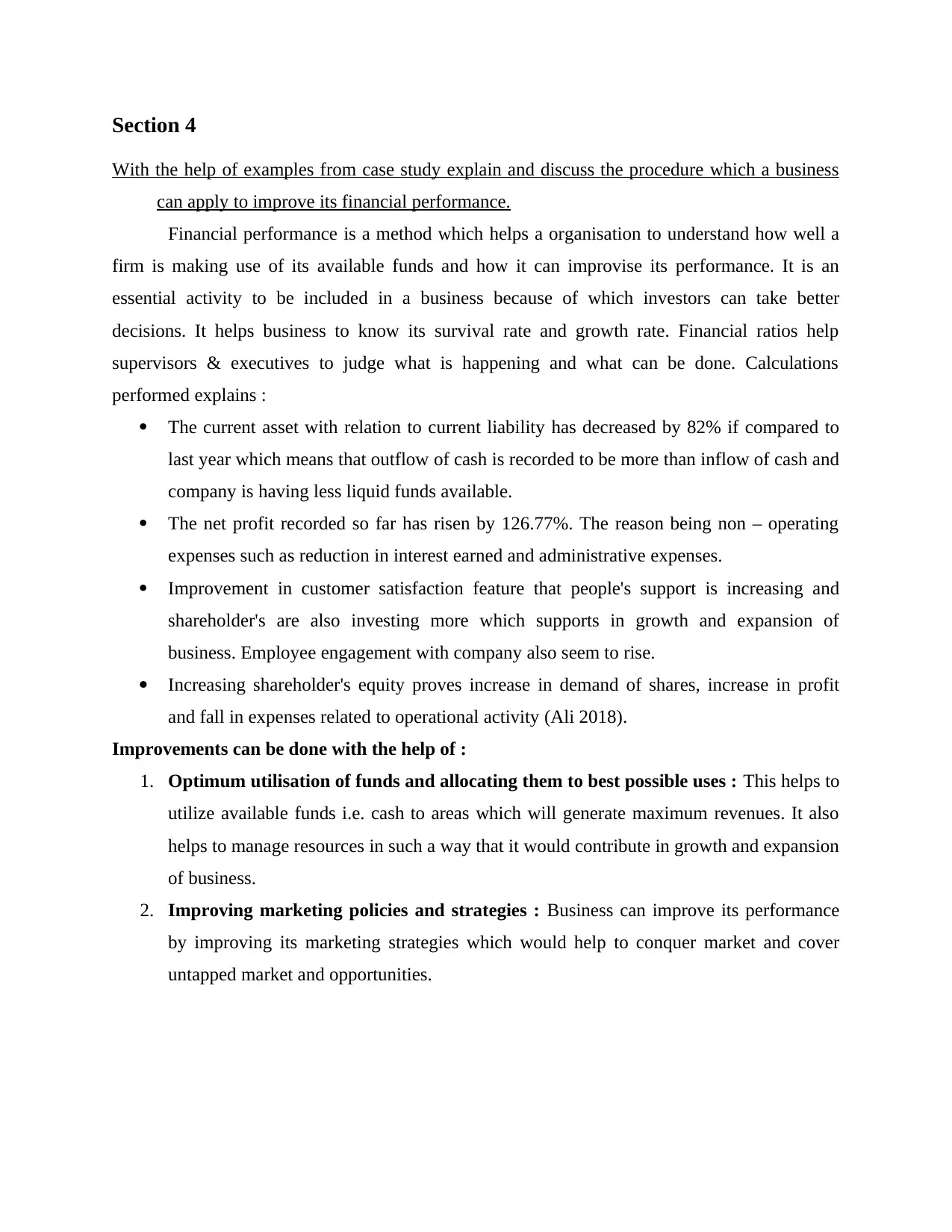
Section 4
With the help of examples from case study explain and discuss the procedure which a business
can apply to improve its financial performance.
Financial performance is a method which helps a organisation to understand how well a
firm is making use of its available funds and how it can improvise its performance. It is an
essential activity to be included in a business because of which investors can take better
decisions. It helps business to know its survival rate and growth rate. Financial ratios help
supervisors & executives to judge what is happening and what can be done. Calculations
performed explains :
The current asset with relation to current liability has decreased by 82% if compared to
last year which means that outflow of cash is recorded to be more than inflow of cash and
company is having less liquid funds available.
The net profit recorded so far has risen by 126.77%. The reason being non – operating
expenses such as reduction in interest earned and administrative expenses.
Improvement in customer satisfaction feature that people's support is increasing and
shareholder's are also investing more which supports in growth and expansion of
business. Employee engagement with company also seem to rise.
Increasing shareholder's equity proves increase in demand of shares, increase in profit
and fall in expenses related to operational activity (Ali 2018).
Improvements can be done with the help of :
1. Optimum utilisation of funds and allocating them to best possible uses : This helps to
utilize available funds i.e. cash to areas which will generate maximum revenues. It also
helps to manage resources in such a way that it would contribute in growth and expansion
of business.
2. Improving marketing policies and strategies : Business can improve its performance
by improving its marketing strategies which would help to conquer market and cover
untapped market and opportunities.
With the help of examples from case study explain and discuss the procedure which a business
can apply to improve its financial performance.
Financial performance is a method which helps a organisation to understand how well a
firm is making use of its available funds and how it can improvise its performance. It is an
essential activity to be included in a business because of which investors can take better
decisions. It helps business to know its survival rate and growth rate. Financial ratios help
supervisors & executives to judge what is happening and what can be done. Calculations
performed explains :
The current asset with relation to current liability has decreased by 82% if compared to
last year which means that outflow of cash is recorded to be more than inflow of cash and
company is having less liquid funds available.
The net profit recorded so far has risen by 126.77%. The reason being non – operating
expenses such as reduction in interest earned and administrative expenses.
Improvement in customer satisfaction feature that people's support is increasing and
shareholder's are also investing more which supports in growth and expansion of
business. Employee engagement with company also seem to rise.
Increasing shareholder's equity proves increase in demand of shares, increase in profit
and fall in expenses related to operational activity (Ali 2018).
Improvements can be done with the help of :
1. Optimum utilisation of funds and allocating them to best possible uses : This helps to
utilize available funds i.e. cash to areas which will generate maximum revenues. It also
helps to manage resources in such a way that it would contribute in growth and expansion
of business.
2. Improving marketing policies and strategies : Business can improve its performance
by improving its marketing strategies which would help to conquer market and cover
untapped market and opportunities.
Paraphrase This Document
Need a fresh take? Get an instant paraphrase of this document with our AI Paraphraser
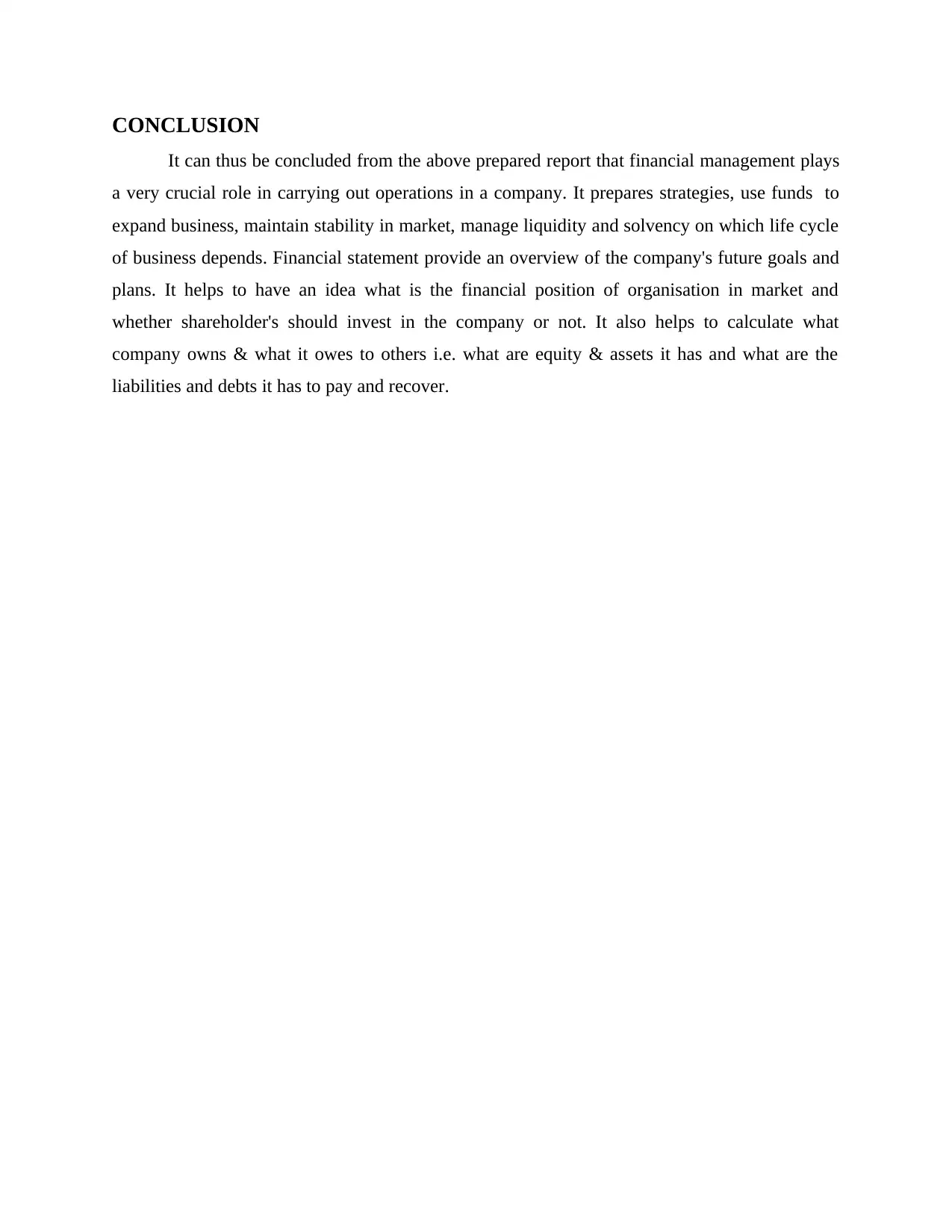
CONCLUSION
It can thus be concluded from the above prepared report that financial management plays
a very crucial role in carrying out operations in a company. It prepares strategies, use funds to
expand business, maintain stability in market, manage liquidity and solvency on which life cycle
of business depends. Financial statement provide an overview of the company's future goals and
plans. It helps to have an idea what is the financial position of organisation in market and
whether shareholder's should invest in the company or not. It also helps to calculate what
company owns & what it owes to others i.e. what are equity & assets it has and what are the
liabilities and debts it has to pay and recover.
It can thus be concluded from the above prepared report that financial management plays
a very crucial role in carrying out operations in a company. It prepares strategies, use funds to
expand business, maintain stability in market, manage liquidity and solvency on which life cycle
of business depends. Financial statement provide an overview of the company's future goals and
plans. It helps to have an idea what is the financial position of organisation in market and
whether shareholder's should invest in the company or not. It also helps to calculate what
company owns & what it owes to others i.e. what are equity & assets it has and what are the
liabilities and debts it has to pay and recover.
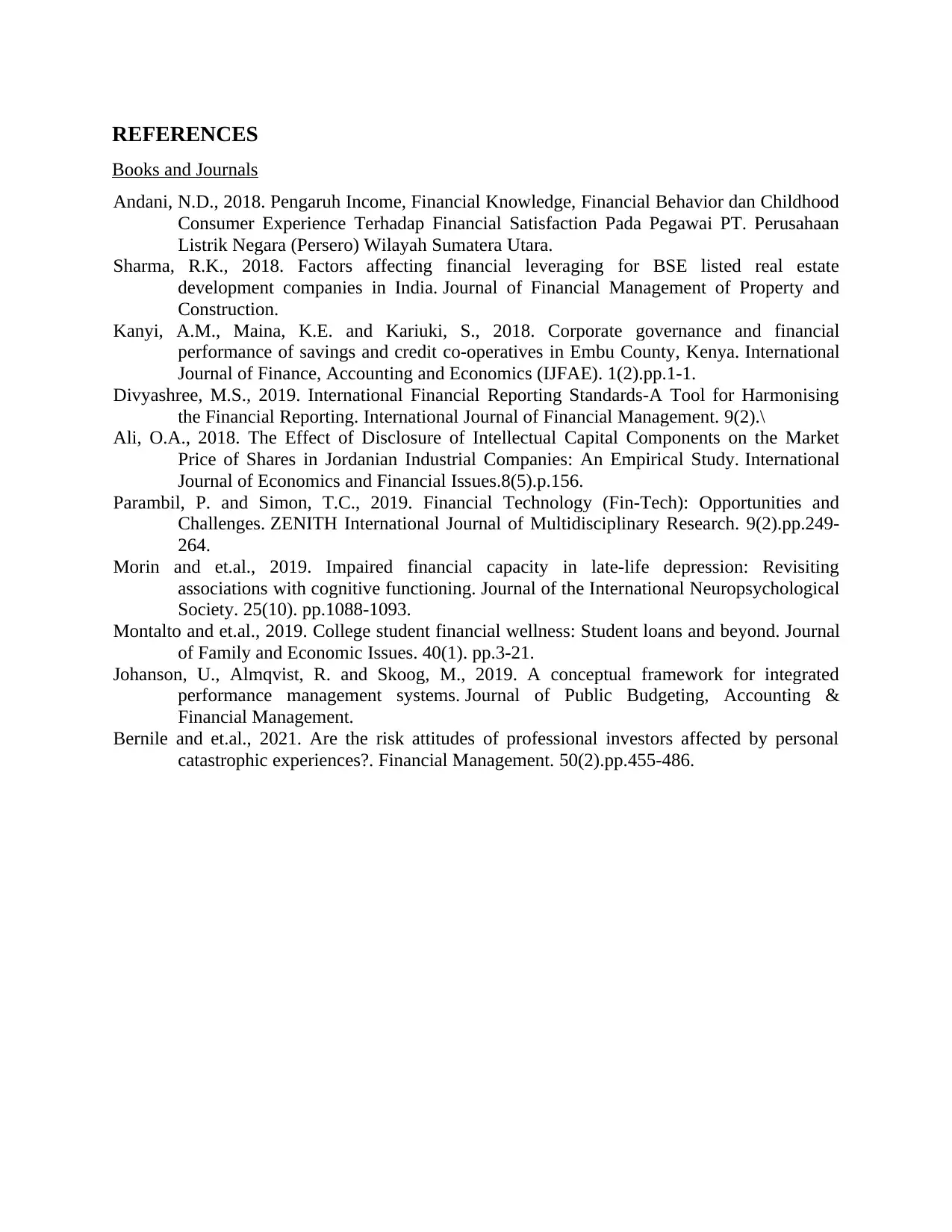
REFERENCES
Books and Journals
Andani, N.D., 2018. Pengaruh Income, Financial Knowledge, Financial Behavior dan Childhood
Consumer Experience Terhadap Financial Satisfaction Pada Pegawai PT. Perusahaan
Listrik Negara (Persero) Wilayah Sumatera Utara.
Sharma, R.K., 2018. Factors affecting financial leveraging for BSE listed real estate
development companies in India. Journal of Financial Management of Property and
Construction.
Kanyi, A.M., Maina, K.E. and Kariuki, S., 2018. Corporate governance and financial
performance of savings and credit co-operatives in Embu County, Kenya. International
Journal of Finance, Accounting and Economics (IJFAE). 1(2).pp.1-1.
Divyashree, M.S., 2019. International Financial Reporting Standards-A Tool for Harmonising
the Financial Reporting. International Journal of Financial Management. 9(2).\
Ali, O.A., 2018. The Effect of Disclosure of Intellectual Capital Components on the Market
Price of Shares in Jordanian Industrial Companies: An Empirical Study. International
Journal of Economics and Financial Issues.8(5).p.156.
Parambil, P. and Simon, T.C., 2019. Financial Technology (Fin-Tech): Opportunities and
Challenges. ZENITH International Journal of Multidisciplinary Research. 9(2).pp.249-
264.
Morin and et.al., 2019. Impaired financial capacity in late-life depression: Revisiting
associations with cognitive functioning. Journal of the International Neuropsychological
Society. 25(10). pp.1088-1093.
Montalto and et.al., 2019. College student financial wellness: Student loans and beyond. Journal
of Family and Economic Issues. 40(1). pp.3-21.
Johanson, U., Almqvist, R. and Skoog, M., 2019. A conceptual framework for integrated
performance management systems. Journal of Public Budgeting, Accounting &
Financial Management.
Bernile and et.al., 2021. Are the risk attitudes of professional investors affected by personal
catastrophic experiences?. Financial Management. 50(2).pp.455-486.
Books and Journals
Andani, N.D., 2018. Pengaruh Income, Financial Knowledge, Financial Behavior dan Childhood
Consumer Experience Terhadap Financial Satisfaction Pada Pegawai PT. Perusahaan
Listrik Negara (Persero) Wilayah Sumatera Utara.
Sharma, R.K., 2018. Factors affecting financial leveraging for BSE listed real estate
development companies in India. Journal of Financial Management of Property and
Construction.
Kanyi, A.M., Maina, K.E. and Kariuki, S., 2018. Corporate governance and financial
performance of savings and credit co-operatives in Embu County, Kenya. International
Journal of Finance, Accounting and Economics (IJFAE). 1(2).pp.1-1.
Divyashree, M.S., 2019. International Financial Reporting Standards-A Tool for Harmonising
the Financial Reporting. International Journal of Financial Management. 9(2).\
Ali, O.A., 2018. The Effect of Disclosure of Intellectual Capital Components on the Market
Price of Shares in Jordanian Industrial Companies: An Empirical Study. International
Journal of Economics and Financial Issues.8(5).p.156.
Parambil, P. and Simon, T.C., 2019. Financial Technology (Fin-Tech): Opportunities and
Challenges. ZENITH International Journal of Multidisciplinary Research. 9(2).pp.249-
264.
Morin and et.al., 2019. Impaired financial capacity in late-life depression: Revisiting
associations with cognitive functioning. Journal of the International Neuropsychological
Society. 25(10). pp.1088-1093.
Montalto and et.al., 2019. College student financial wellness: Student loans and beyond. Journal
of Family and Economic Issues. 40(1). pp.3-21.
Johanson, U., Almqvist, R. and Skoog, M., 2019. A conceptual framework for integrated
performance management systems. Journal of Public Budgeting, Accounting &
Financial Management.
Bernile and et.al., 2021. Are the risk attitudes of professional investors affected by personal
catastrophic experiences?. Financial Management. 50(2).pp.455-486.
⊘ This is a preview!⊘
Do you want full access?
Subscribe today to unlock all pages.

Trusted by 1+ million students worldwide
1 out of 15
Related Documents
Your All-in-One AI-Powered Toolkit for Academic Success.
+13062052269
info@desklib.com
Available 24*7 on WhatsApp / Email
![[object Object]](/_next/static/media/star-bottom.7253800d.svg)
Unlock your academic potential
Copyright © 2020–2025 A2Z Services. All Rights Reserved. Developed and managed by ZUCOL.


